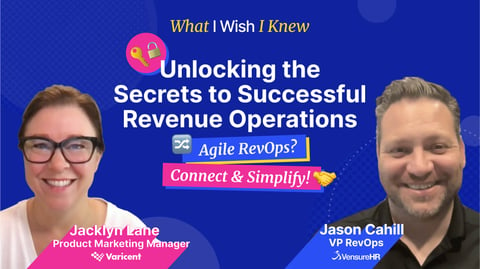Full funnel measurement is the holy grail for revenue operations and marketing leaders. If you can measure everything from lead-to-revenue, you can accurately model the growth of your business and measure if you’re veering off track earlier by identifying trends in real time at the top of the funnel.
But there are substantial challenges to measuring the full funnel, and it starts with changing how we measure leads. In this post, I want to break those down and discuss how you can connect your data.
In this post, I’ll be referencing our 3VC model as core metrics – value, volume, velocity, and conversion rates.
The problem with “leads”
Last year I wrote The Measurable Lead Model to try and break down some of the problems with waterfall models and ABM models for measuring what do we do with leads.
We still need a method to understand how many leads we’re creating, and how they’re impacting the business.
Think about these questions and how answering them would change the way you design programs:
- Do you know how many leads are from accounts that are already in active opportunities/pipeline? Of those do you know how many are enabling the deal the move further through the funnel?
- Do you know how many leads are coming from existing customer accounts?
- Do you know how many leads are second or third sales attempts?
- Do you know how many leads are new?
In reality, you’re creating all of these leads all the time. The challenge comes with measuring leads and impact on pipeline. If you generate 1,000 MQLs this month, what amount of them are in each of those categories?
There are two main problems I see often:
- measuring leads by using the created date – the date you’re added them to your database – to cohort their reporting. This is inaccurate because it only accounts for a single sales attempt (or no sales attempt). It’s simply the date you knew the person’s email address.
- Only measuring and building processes for the Lead object, but not the Contact object in Salesforce. This is a glaring oversight – what happens when you convert a Lead to a Contact, subsequently lose that opportunity, and 6 months later that person (now a Contact in your database) requests a demo?
Because of issues in the Salesforce data model, it can be hard to get at these answers in Salesforce – but you can answer all of these questions with our full funnel reporting. But first, let’s dive into why this is important.
-
why cohort dates matter for all your reporting
-
why account-based and people-based reports need to be considered
-
how measuring the full funnel gives you super powers
1. Cohorts: are they ratios or conversion rates?
One of the largest challenges with connecting the full funnel is how you cohort your data.
In an ideal world, you want to measure from when the lead became known to you – how long does it take to:
-
assign the lead to a sales rep?
-
convert it to an opportunity?
-
reach a pipeline stage?
-
become a won customer?
In practice, it’s pretty difficult to get that data out of Salesforce. For example, these are the easy to access dates you can report from:
Lead/Contact
- Created Date
- Campaign Date
- Assigned Date
Opportunity
- Created date
- Pipeline date
- Close Date
For many organizations, the lead and opportunity funnels are disconnected, and reports will use one date for leads, and another for opportunities – meaning these data sets aren’t connected, they’re approximate. The funnel is presented as point in time ratios.
Within Varicent Lift, we’ve grouped all of these dates on a unified timeline through the account – enabling us to see where a person is in their lifecycle and view it in relation to what’s happening in the opportunity.
This enables you to view the full funnel from a single cohort date.
2. Accounts add a complication to conversion rates
Another challenge to reporting is that leads/contacts use a person model, and accounts/opportunities use an account model. This makes it very difficult for many businesses to create a full funnel view of conversion rates.
Let’s look at a scenario:
5 leads come in today. No new opportunities are created. What a waste.
But what if those 5 leads are all from the same account? And that account has an active opportunity? Is that still a waste?
Let’s say those 5 leads are from the same account, but a new opportunity. You have 5 leads convert to 1 opportunity – is that a 20% conversion rate? Or is it 1 account is engaged, and converted to 1 opportunity, and 100% conversion rate?
There are a number of scenarios that can happen with leads coming in:
New person
- New person ? New Opp(s)
- New person ? Existing Opp(s)
- New person ? Existing Customer
Existing person
- Existing person ? New Opp(s)
- Existing person ? Existing Opp(s)
- Existing person ? Existing Customer
The language “existing” is another complication. Does existing mean they are in your database, or does it mean you’re actively selling to them? As your database grows from previous sales attempts, you’ll have more accounts and more contacts that exist but do not currently have active opportunities. Your goal with this group is the nurture them back into the top of the funnel.
Depending on the question you want to ask, you need to look at these numbers in both directions. If Marketing generates 100 inbound leads, but all 100 are from the same account, did you meet your lead target?
Here’s how I would ask the questions:
- How many leads did we assign to from scratch (meaning, they don’t belong to any accounts of opportunities)?
- How many leads did we assign from accounts we don’t have an active opportunity with (meaning, we’ve talked to the account before, but aren’t actively selling to right now)?
- How many leads did we assign from accounts we’re already selling to (meaning, they have an active opportunity)?
- How many leads did we assign that are from existing customers? How many of those have upcoming renewals or expansion opportunities?
By measuring the full funnel, you can identify problems early enough to solve them. Segmenting your lead reporting enables you to identify early if Marketing is generating the right kinds of leads.
Here’s a quick example of how changing measurement can change the targets and programs marketing focuses on.
- You need to generate 1,000 new leads this month
- You generate 1,000 new leads! Great. But new pipeline is below target, what’s going on?
- Let’s say that 300 of those leads were attached to existing opportunities, or existing customers, the performance is really 700 new leads – off target, but in a way that you can easily troubleshoot what happened.
Without this context, you’d need to dig further into your data to identify why leads stopped converting – was it response time, cadence compliance, a bad campaign, the wrong segment? It might be that they were just people you already knew.
Using this, you can reframe the targets you create for your team into the categories outlined above: net new sales attempts, impacts to existing sales attempts, impacts to existing customers (in addition to existing dispositions like unqualified leads).
The same is true for understanding the person ? account conversion rate, and how that impacts what “1,000 new leads” really means.
Unify your data with Varicent
With Varicent Lift's revenue intelligence, we’ve modelled Salesforce data to make it easy to understand the person/account model, and the time-based model. We’d love to show you how this works, if you’re interested you can book some time with our team or try out our free sales rep grader.



